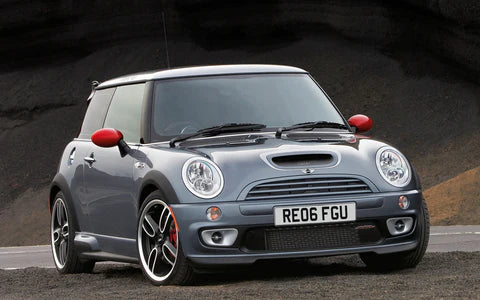
The re launch of the Mini brand in the United States occurred during the 2002 model year, with the Cooper (R50) and Cooper S (R53) making their way across the Atlantic. While the overall design of the R50/R53 hatchback remained similar throughout the production run, there are several major changes that are worth noting. The 2002 to July of 2004 Coopers are known as the “pre-facelift” and can be distinguished from the post July/2004 “post-facelift” Coopers rather easily once you know what you are looking for.
Engine Changes:
The engines themselves remained the same throughout the R50/R53 generation, but the supercharged Cooper S models received a handful of upgrades to increase power and improve driving dynamics. Facelift Cooper S cars received an improved supercharger including Teflon coated rotors for improved durability. A revision to the ECU along with exhaust improvements helped the facelift Cooper S gain an additional 7 horsepower over its non-facelift predecessor. The engine mount design changed from a rubber mount to a fluid-filled unit, and the exhaust hangers also underwent a change in design, although these changes actually pre-dated the official facelift in July. This is why many aftermarket exhaust systems include bracket relocators for pre-facelift cars. The facelift Cooper S became well-known for the increased “popping” noises coming from the exhaust due to these changes. Fuel pumps were also changed during the facelift, along with the fuel tank and mounting system.
Transmission Changes:
Cooper S
From 2002 to July of 2004, the Cooper S was not available with an automatic transmission. The facelift Cooper S models came with an optional Aisin-built 6-speed automatic transmission with paddle shifters. The 6-speed manual transmission also changed in late 2004, with revised gear ratios and an optional limited-slip differential becoming available. The limited-slip differential quickly became a popular option for autocross racers.
Base Cooper
The base model Coopers were always available with a CVT transmission, a ZF unit that has a reputation for being extremely problematic. The 2002-2004 base models came with a 5-speed manual that also has its fair share of issues. Known as the Midlands gearbox, this transmission is so problematic that R50 owners often swap their 5-speed manual transmissions for the Cooper S’s 6-speed. The Midlands gearbox was replaced by a Getrag unit for the facelift base Coopers. The transmission changes are accompanied by changes to the axles and the shifter.
Exterior Changes:
The headlight design is a major exterior change for facelift cars. Both pre-facelift and post-facelift cars were offered with Xenon headlights as an option, but the housings differ greatly in appearance. The pre-facelift housings were a reflector housing, but specifically re-engineered for the Xenon bulb. The post-facelift lights had the traditional projector style Xenon light. Both the base and S models had changes to the rear bumpers in July of 2004. Both models also experienced changes to the front grilles. In the rear of the car, the tail lights were changed to incorporate the reverse lights, while the previous bumper-mounted reverse light were replaced by a rear fog light. Another change to the exterior applies to the antennas. Pre-facelift cars have a different design for the antenna, and navigation equipped cars come with a "shark fin" style antenna. Post-facelift cars come with a similar design for both non-nav and nav-equipped cars.
Pre-facelift front end:

Post-facelift front end: note the change in the chrome trim around the grille.
Pre-facelift rear end: note the reverse light location.

Post-facelift rear end: the reverse light is now part of the tail lights.

Interior Changes:
The interior changes are extremely noticeable between pre-and post-facelift Coopers. The dash changed from a 5-piece design with the passenger airbag module located in the lower part of the dash, to a 3-piece design with the airbag located on the upper part. The upper dash is also of a different shape. The steering wheel switched from a 2-spoke to a 3-spoke design, and the steering wheel airbag and switches are different. The design of the door armrests, panels, and the center console also changed. The factory clock moved from the roof of the car to the speedometer. The interior of the facelift cars is generally much better and less prone to rattles, with materials being upgraded throughout. New seat designs incorporating seat airbag sensors for the passengers were implemented, along with new color options. Colors could also be changed on the dash and the headliner, giving buyers more options for customizing their Minis. The headliner design is also different between the facelift cars, as they received a lateral sun visor for the driver and an assist/grab handle for the passengers.
Pre-facelift dash and steering wheel

Post-facelift dash and steering wheel. Note the 3 piece dash design and 3-spoke steering wheel.

Suspension/Chassis Changes:
Changes to the suspension and chassis are few for the facelift in this generation. July of 2004 and on cars all come with mounting holes to put the convertible front braces. These braces help with stiffness and reduce vibrations. The other change to the suspension is the rear trailing arm and bracket design, as these were also updated during the facelift.
As you can see, the first-generation Cooper underwent a plethora of changes during its production run. Most Cooper enthusiasts would say that the facelift cars are the most desirable, as the interior and engine changes are extremely well liked. On the other hand, many owners preferred some of the quirky-natured parts of the pre-facelift models, such as the two-spoke steering wheel. It is well known that the facelift models have many of the kinks worked out and as such are more reliable than early R50/R53s. If we were to recommend a first generation, a facelift car would be the one to get.


